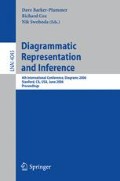Abstract
This paper describes the evaluation of ERST, an adaptive system which is designed to improve its users’ external representation (ER) selection accuracy on a range of database query tasks. The design of the system was informed by the results of experimental studies. Those studies examined the interactions between the participants’ background knowledge-of-external representations, their preferences for selecting particular information display forms, and their performance across a range of tasks involving database queries. The paper describes how ERST’s adaptation is based on predicting users’ ER-to-task matching skills and performance at reasoning with ERs, via a Bayesian user model. The model drives ERST’s adaptive interventions in two ways – by 1. hinting to the user that particular representations be used, and/or 2. by removing from the user the opportunity to select display forms which have been associated with prior poor performance for that user. The results show that ERST does improve an individual’s ER reasoning performance. The system is able to successfully predict users’ ER-to-task matching skills and their ER reasoning performance via its Bayesian user model.
Access this chapter
Tax calculation will be finalised at checkout
Purchases are for personal use only
Preview
Unable to display preview. Download preview PDF.
References
Brusilovsky, P., Eklund, J.: A study of user model based link annotation in educational hypermedia. Journal of Universal Computer Science, special issue on assessment issues for educational software 4, 429–448 (1998)
Cheng, P.C.-H.: Functional roles for the cognitive analysis of diagrams in problem solving. In: Cottrell, G.W. (ed.) Proceedings of the 18th Annual Conference of the Cognitive Science Society, pp. 207–212. Lawrence Erlbaum Associates, Mahwah (1996)
Conati, C., Gertner, A., VanLehn, K.: Using Bayesian networks to manage uncertainly in student modeling. User Modeling & User-Adapted Interaction 12, 371–417 (2002)
Cox, R., Brna, P.: Supporting the use of external representations in problem solving: The need for flexible learning environments. Journal of Artificial Intelligence in Education 6, 239–302 (1995)
Cox, R., Stenning, K., Oberlander, J.: The effect of graphical and sentential logic teaching on spontaneous external representation. Cognitive Studies: Bulletin of the Japanese Cognitive Science Society 2, 5–75 (1995)
Cox, R.: Representation construction, externalised cognition and individual differences. Learning and Instruction 9, 343–363 (1999)
Cox, R., Grawemeyer, B.: The mental organisation of external representations. In: European Cognitive Science Conference (EuroCogSci). Osnabrück (2003)
Cox, R., Romero, P., du Boulay, B., Lutz, R.: A cognitive processing perspective on student programmers’ ‘graphicacy’. In: Blackwell, A.F., Marriott, K., Shimojima, A. (eds.) Diagrams 2004. LNCS (LNAI), vol. 2980, pp. 344–346. Springer, Heidelberg (2004)
Day, R.: Alternative representations. In: Bower, G. (ed.) The Psychology of Learning and Motivation, vol. 22, pp. 261–305 (1988)
Grawemeyer, B., Cox, R.: The effects of knowledge of external representations and display selection upon database query performance. In: Proceedings of the Second International Workshop on Interactive Graphical Communication (IGC 2003), University of London, Queen Mary (2003)
Grawemeyer, B., Cox, R.: A Bayesian approach to modelling user’s information display preferences. In: Ardissono, L., Brna, P., Mitrović, A. (eds.) UM 2005. LNCS (LNAI), vol. 3538, pp. 233–238. Springer, Heidelberg (2005)
Grawemeyer, B., Cox, R.: Graphical data displays and database queries: Helping users select the right display for the task. In: Butz, A., Fisher, B., Krüger, A., Olivier, P. (eds.) SG 2005. LNCS, vol. 3638, pp. 53–64. Springer, Heidelberg (2005)
Humphreys, G.W., Riddoch, M.J.: Visual object processing: A cognitive neuropsychological approach. Lawrence Erlbaum Associates, Hillsdale (1987)
Jameson, A., Gromann-Hutter, B., March, L., Rummer, R.: Creating an empirical basis for adaptation decisions. In: Lieberman, H. (ed.) IUI 2000: International Conference on Intelligent User Interfaces (2000)
Kirby, J.R., Moore, P.J., Schofield, N.J.: Verbal and visual learning styles. Contemporary educational psychology 13, 169–184 (1988)
Kozhevnikov, M., Hegarty, M., Mayer, R.E.: Visual/spatial abilities in problem solving in physics. In: Anderson, M., Mayer, B., Olivier, P. (eds.) Diagrammatic representation and reasoning, Springer, Heidelberg (2002)
Mitchell, T.M.: Machine learning. McGraw Hill, New York (1997)
Norman, D.A.: Things that make us smart. Addison-Wesley, MA (1993)
Novick, L.R., Hurley, S.M., Francis, M.: Evidence for abstract, schematic knowledge of three spatial diagram representations. Memory & Cognition 27, 288–308 (1999)
Novick, L.R., Hurley, S.M.: To Matrix, Network, or Hierarchy: That Is the Question. Cognitive Psychology 42, 158–216 (2001)
Pearl, J.: Probabilistic reasoning in intelligent systems: Networks of Plausible Inference. Morgan Kaufmann, San Francisco (1988)
Shute, V.J., Gawlick-Grendell, L.A., Young, R.K., Burnham, C.A.: An experimental system for learning probability: Stat Lady description and evaluation. Instructional Science 24, 25–46 (1996)
Stenning, K., Cox, R., Oberlander, J.: Contrasting the cognitive effects of graphical and sentential logic teaching: Reasoning, representation and individual differences. Language and Cognitive Processes 10, 333–354 (1995)
Vessey, I.: Cognitive fit: A theory-based analysis of the graphs versus tables literature. Decision Sciences 22, 219–241 (1991)
Weibelzahl, S.: Problems and Pitfalls in Evaluating Adaptive Systems. In: Chen, S., Magoulas, G. (eds.) Adaptable and Adaptive Hypermedia Systems, pp. 285–299. IRM Press, Heshey (2005)
Author information
Authors and Affiliations
Editor information
Editors and Affiliations
Rights and permissions
Copyright information
© 2006 Springer-Verlag Berlin Heidelberg
About this paper
Cite this paper
Grawemeyer, B. (2006). Evaluation of ERST – An External Representation Selection Tutor. In: Barker-Plummer, D., Cox, R., Swoboda, N. (eds) Diagrammatic Representation and Inference. Diagrams 2006. Lecture Notes in Computer Science(), vol 4045. Springer, Berlin, Heidelberg. https://doi.org/10.1007/11783183_21
Download citation
DOI: https://doi.org/10.1007/11783183_21
Publisher Name: Springer, Berlin, Heidelberg
Print ISBN: 978-3-540-35623-3
Online ISBN: 978-3-540-35624-0
eBook Packages: Computer ScienceComputer Science (R0)

